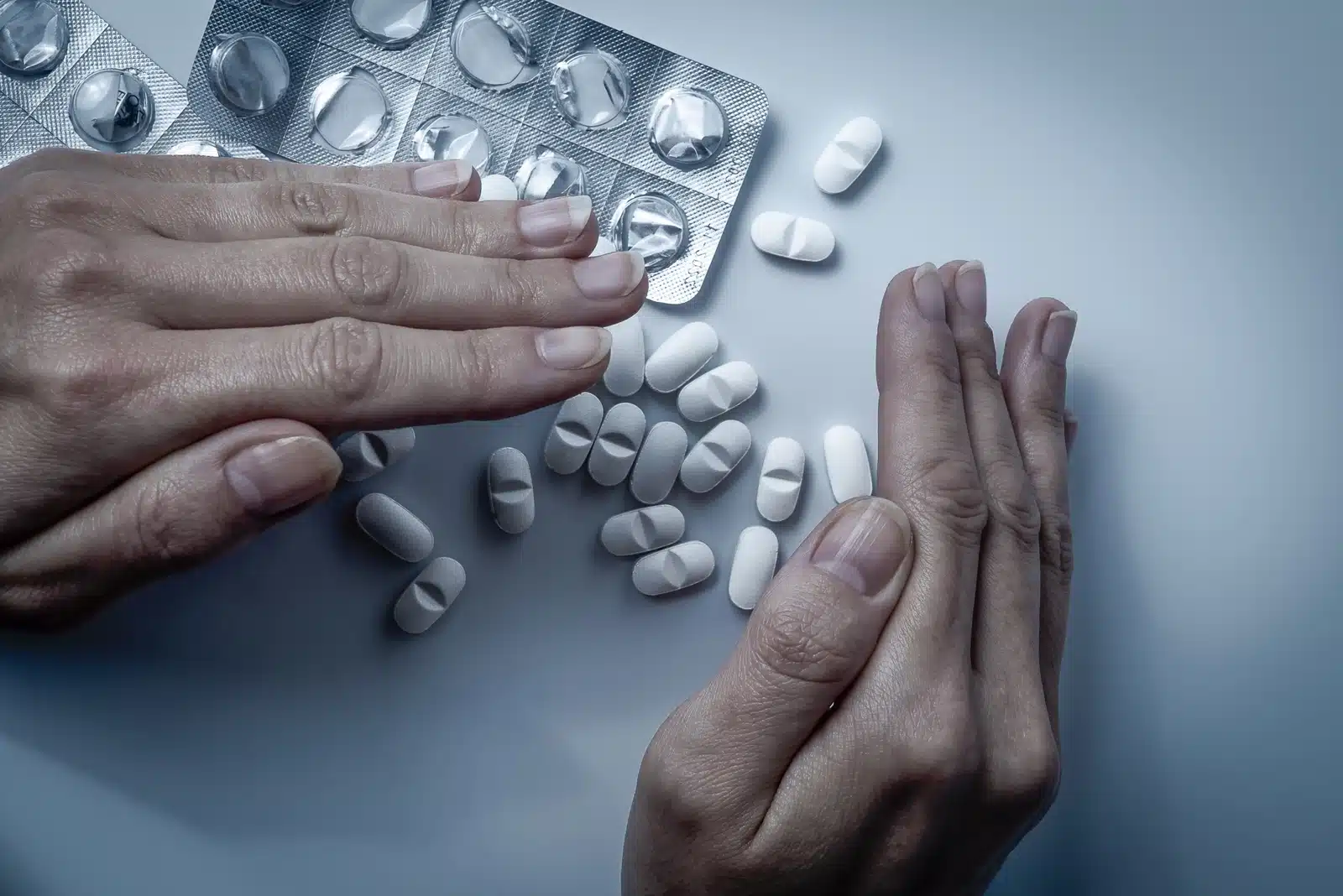Substances
How Does Suboxone Work? Mechanism and Drug Facts For Suboxone
Medically Reviewed By
Written By
Last medically reviewed March 24, 2025
Substances
Medically Reviewed By
Written By
Last medically reviewed March 24, 2025

Suboxone offers hope for many people struggling with opioid addiction. When properly prescribed and monitored by healthcare professionals, Suboxone can reduce cravings, minimize withdrawal symptoms, and help people maintain their recovery journey. For those feeling trapped in the cycle of addiction, Suboxone is a scientifically backed option that has helped countless people regain control of their lives and work toward long-lasting recovery.
Suboxone is a prescription medication approved by the FDA for treating opioid use disorder.[1] It contains two active ingredients working together to help people overcome opioid dependence: buprenorphine and naloxone.
Buprenorphine is a partial opioid agonist that attaches to the same brain receptors as other opioids (like heroin or prescription painkillers) but only partially activates them.[2] This helps to:
Naloxone is an opioid antagonist implemented as a deterrent to misuse. If someone attempts to inject Suboxone rather than taking it as prescribed (under the tongue), the naloxone becomes active and can:[3]
In a nutshell, suboxone works by maintaining enough opioid receptor activity to prevent withdrawal and cravings while blocking other opioids from fully activating these receptors. This creates a ceiling effect where taking more Suboxone or other opioids won’t produce additional euphoria, helping break the cycle of addiction.
Suboxone’s effectiveness in treating opioid use disorder stems from its unique pharmacological properties and interactions with the brain’s opioid system. The medication works through a sophisticated mechanism that provides relief from withdrawal and cravings while deterring misuse:[4]

Opioid use disorder (OUD) is a medical condition that develops when a person is addicted to or dependent on either illicit or prescription opioids. It develops when repeated opioid use changes the brain’s structure and function, affecting areas responsible for reward, stress, and self-control.[5] These neurological changes often lead to intense cravings, tolerance (needing increasing amounts to achieve the same effect), and withdrawal symptoms when use is reduced or stopped.
A diagnosis of OUD is made by a professional around specific criteria outlined in the Diagnostic and Statistical Manual of Mental Disorders (DSM-5), including unsuccessful efforts to cut down use, spending significant time obtaining or using opioids, continuing use despite physical or psychological problems, and experiencing withdrawal symptoms.[6] OUD exists on a spectrum from mild to severe, depending on how many criteria are met.
This condition affects people across all demographics and socioeconomic backgrounds, challenging outdated stigmas that portray addiction as simply a moral failing or lack of willpower. Medical science recognizes OUD as a treatable medical condition requiring comprehensive care that may include medications like Suboxone, counseling, and support services.
Suboxone can provide a foundation for recovery while reducing the risks associated with continued opioid use or abrupt discontinuation: [7]
Suboxone can be misused despite its inherent benefits to addiction treatment.[8] The buprenorphine component, while only a partial opioid agonist, can still produce euphoric effects, particularly in people with no opioid tolerance. This potential for misuse exists even though Suboxone was specifically formulated with naloxone to deter improper use. When taken as prescribed (under the tongue), naloxone has minimal effect, but if crushed and injected, naloxone becomes active and can trigger withdrawal symptoms.
The risk of Suboxone misuse is significantly lower than with full opioid agonists like heroin or oxycodone. However, some people may attempt to misuse Suboxone by taking higher doses than prescribed, combining it with other substances like benzodiazepines or alcohol to enhance its effects, or diverting their prescription to others. This is why healthcare providers carefully evaluate patients before prescribing Suboxone and implement monitoring strategies throughout treatment, including regular appointments, urine drug screens, and prescription tracking.
Ultimately, when used as directed under proper medical supervision, Suboxone remains a valuable and relatively safe component of opioid addiction treatment.
Suboxone contains two medications: buprenorphine, a partial opioid agonist, and naloxone, an opioid antagonist. Buprenorphine attaches to the same opioid receptors in the brain that drugs like fentanyl, heroin, and oxycodone target but activates them only partially.
This helps reduce withdrawal symptoms and cravings while preventing the euphoric high associated with full opioid agonists. Naloxone is included to deter misuse – it remains inactive when Suboxone is taken as prescribed (under the tongue as a sublingual film) but can trigger withdrawal if the medication is crushed and injected.
Both Suboxone and methadone are FDA-approved medications for opioid dependence treatment, but they work differently. Methadone is a full opioid agonist, meaning it fully activates opioid receptors, while buprenorphine in Suboxone is only a partial agonist with a ceiling effect that limits potential overdose.
Methadone typically requires daily visits to specialized clinics, especially during initial treatment. Suboxone can be prescribed in outpatient settings by qualified healthcare providers and taken at home. This accessibility makes Suboxone treatment more convenient for many patients, allowing them to maintain work and family responsibilities while receiving care.
Common side effects of Suboxone include headache, nausea, constipation, insomnia, sweating, and drowsiness. Most side effects are mild and diminish over time as your body adjusts to the medication. More serious but less common effects may include respiratory depression (especially when combined with sedatives like benzodiazepines), liver problems, or allergic reactions. Your healthcare provider should monitor you regularly throughout treatment.
If you’re experiencing troublesome side effects, don’t stop taking Suboxone without medical advice, as this could trigger opioid withdrawal syndrome.
The duration of Suboxone treatment varies greatly depending on individual circumstances. Some people benefit from short-term use during detoxification from opiates like painkillers, while others may need long-acting medication-assisted treatment (MAT) for months, years, or indefinitely.
The current medical understanding of OUD recognizes it as a chronic condition similar to diabetes or hypertension, sometimes requiring long-term management. Your treatment plan should be developed collaboratively with your healthcare provider and may include behavioral therapy, mental health support, and regular check-ins. The goal is stable recovery, not necessarily the discontinuation of medication.
Transitioning to Suboxone requires careful timing. You must be in a state of mild to moderate opioid withdrawal before taking your first dose of buprenorphine/naloxone. Taking Suboxone too soon after using short-acting opioids like heroin or oxycodone can trigger precipitated withdrawal – an intense, sudden onset of withdrawal symptoms.
This happens because buprenorphine displaces other opioids from receptors without fully activating them. Your healthcare provider will typically instruct you to wait until you’re experiencing withdrawal symptoms (usually 12-24 hours after your last opioid use, longer for long-acting opioids) before starting Suboxone. Many treatment programs and primary care providers offer guidance through this critical transition period.
[1] Entringer, S. (2023, August 23). Suboxone Uses, Dosage, Side Effects & Warnings. Drugs.com. https://www.drugs.com/suboxone.html on March 17, 2025
[2] Kumar, R., Viswanath, O., & Saadabadi, A. (2024, June 8). Buprenorphine. PubMed; StatPearls Publishing. https://www.ncbi.nlm.nih.gov/books/NBK459126/ on March 17, 2025
[3]U.S. Department of Health and Human Services. (2024a, February 12). Naloxone drugfacts. National Institutes of Health. https://nida.nih.gov/publications/drugfacts/naloxone
[4] Togioka, B. M., & Patel, P. (2024). Buprenorphine and Naloxone. PubMed; StatPearls Publishing. https://www.ncbi.nlm.nih.gov/books/NBK603725/ on March 17, 2025
[5] American Psychiatric Association. (2022, December). Opioid Use Disorder. Psychiatry.org; American Psychiatric Association. https://www.psychiatry.org/Patients-Families/Opioid-Use-Disorder on March 17, 2025
[6] DSM-5 Criteria for Diagnosis of Opioid Use Disorder Diagnostic Criteria*. (n.d.). https://www.asam.org/docs/default-source/education-docs/dsm-5-dx-oud-8-28-2017.pdf on March 17, 2025
[7] Kaplan, L. (2018). Medication-assisted treatment for opioid use disorder. The Nurse Practitioner, 1. https://www.cdc.gov/niosh/docs/wp-solutions/2019-133/pdfs/2019-133.pdf on March 17, 2025
[8] Grinspoon, P., MD. (2024, August 8). 5 myths about using Suboxone to treat opioid addiction. Harvard Health. https://www.health.harvard.edu/blog/5-myths-about-using-suboxone-to-treat-opiate-addiction-2018032014496 on March 17, 2025